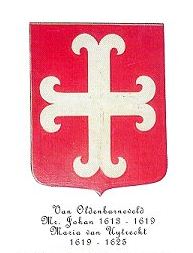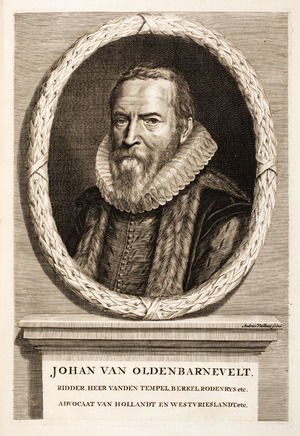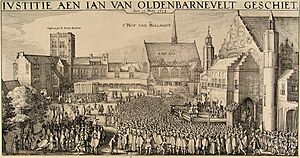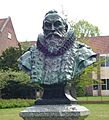Johan van Oldenbarnevelt facts for kids
Quick facts for kids
Johan van Oldenbarnevelt
|
|
|---|---|

|
|
| Grand Pensionary of Holland | |
| In office 1586 – 1619 |
|
| Preceded by | Paulus Buys |
| Succeeded by | Andries de Witt |
| Pensionary of Rotterdam | |
| In office 1576 – 1586 |
|
| Personal details | |
| Born | 14 September 1547 Amersfoort, Spanish Netherlands |
| Died | 13 May 1619 (aged 71) The Hague, Dutch Republic |
| Spouse |
Maria van Utrecht
(m. 1575) |
| Children | Jan van Oldenbarnevelt Adriana Geertruida van Oldenbarnevelt Maria Johanna Petronella van Oldenbarnevelt Reinier van Oldenbarnevelt Willem van Oldenbarnevelt |
| Parents |
|
| Alma mater | University of Leuven University of Bourges University of Cologne Heidelberg University University of Padua |
Johan van Oldenbarnevelt (born September 14, 1547 – died May 13, 1619) was an important Dutch leader and politician. He played a huge part in the Netherlands' fight for freedom from Spain. Many people see him as one of the most important political figures in Dutch history.
Van Oldenbarnevelt was born in Amersfoort. He studied law at several universities, including those in Leuven and Padua. He traveled in France and Italy before settling in The Hague. He supported William the Silent in his fight against Philip II of Spain. Later in his life, he supported a religious group called the Arminians. He also helped create the famous Dutch East India Company.
Contents
Early Political Career
Van Oldenbarnevelt volunteered to help during the sieges of Haarlem (1573) and Leiden (1574). In 1575, he married Maria van Utrecht. A year later, in 1576, he became the pensionary of Rotterdam. This was an important job that made him a member of the States of Holland, which was like the government of the Holland province.
In this role, he quickly became very influential because he was hardworking, understood complex issues, and was a good speaker. He helped create the Union of Utrecht in 1579. This union brought several Dutch provinces together. He also strongly opposed the policies of the Earl of Leicester, who was the governor-general at the time. Instead, he supported Maurice of Nassau, William the Silent's son. When Leicester left in 1587, Maurice took over the military power in the Netherlands.
Becoming Land's Advocate
On March 16, 1586, Van Oldenbarnevelt became the Land's Advocate of Holland. He held this powerful position for 32 years. This job gave him huge influence in the Dutch Republic, which didn't have a strong central government. Even though he was officially a servant of the States of Holland, he became the main political leader of the province. Holland was the most important province and paid for more than half of the union's costs.
He became so powerful that he was almost like the Prime minister of the Dutch Republic. During a difficult time after Leicester left, Van Oldenbarnevelt's leadership stopped the United Provinces from falling apart. This also prevented Spain's powerful army from easily conquering them. Spain was busy planning an invasion of England, which helped the Netherlands.
Van Oldenbarnevelt worked well with Maurice of Nassau. Maurice was mainly interested in leading armies and wasn't very involved in politics. Their first disagreement happened in 1600. Van Oldenbarnevelt convinced the States-General to make Maurice lead a military trip to Flanders. This trip almost ended badly but turned into a victory at the Battle of Nieuwpoort.
After 1598, Van Oldenbarnevelt went on important diplomatic trips to meet King Henry IV of France and Queen Elizabeth I of England. He also visited King James I of England in 1605. He was key in creating the Dutch East India Company (VOC) in 1602. This company brought together several smaller trading companies. The VOC traded for two centuries and developed the idea of using shares for ownership. This allowed people to invest and get their money back by selling shares on a stock exchange. This idea later became common worldwide.
As the main negotiator for Holland, Oldenbarnevelt also led Dutch diplomacy. He managed the talks with Spain that led to the Twelve Years' Truce in 1609. This truce was a ceasefire that lasted for 12 years.
Religious Differences in the Netherlands
The truce made Van Oldenbarnevelt even more powerful in the Dutch Republic, which was now seen as a free country. However, peace outside led to problems inside. For years, there had been arguments between two religious groups: the strict Calvinist Gomarists and the Arminians.
In 1610, the Arminians, also called Remonstrants, wrote a petition. They asked for their beliefs to be discussed at a national church meeting called a synod. Everyone knew that Van Oldenbarnevelt approved of this. He believed in religious toleration, meaning people should be free to believe what they want.
The Gomarists responded with their own petition and asked for a church-only synod. The Dutch Reformed Church split into two groups. The States of Holland, influenced by Van Oldenbarnevelt, supported the Arminians. They refused to allow a church-only synod in 1613. In 1614, they also told preachers in Holland not to talk about these disputed topics in their sermons.
It was hard to make people obey these rules without military help. Riots started in some towns, made worse by economic problems. When Prince Maurice was asked to help as the military leader, he first refused. But then he sided with the Gomarists and helped a Gomarist preacher start a church in The Hague in 1617.
Holland's Bold Move
Van Oldenbarnevelt then took a very bold step. He suggested that the States of Holland, acting as a powerful province, should raise their own local army of 4,000 men. These soldiers, called waardgelders, would help keep the peace.
Meanwhile, the States-General (the main government of the Republic) voted to hold a national church synod. Holland disagreed and, on August 4, 1617, passed a strong resolution called the Scherpe Resolutie. This resolution said that all officials and soldiers paid by Holland had to promise to obey only the States of Holland. They would be answerable to Holland, not to the general courts.
The States-General saw this as Holland declaring itself completely independent. They decided to act. A group was formed, led by Maurice, to make the waardgelders disband. On July 31, 1618, Maurice, with his troops, arrived in Utrecht, which had sided with Holland. He ordered the local soldiers to put down their weapons. As he moved through the towns of Holland, he met no military resistance. The political group supporting Holland was defeated without a fight.
Arrest and Trial
On August 29, 1618, the States-General ordered the arrest of Van Oldenbarnevelt and his main supporters, including Hugo Grotius. They were kept locked up until November. Then, they were questioned by a special group chosen by the States-General. Van Oldenbarnevelt was questioned more than 60 times. His entire political career was closely examined. During this time, he was not allowed to see his papers or write down his defense.
On February 20, 1619, Van Oldenbarnevelt was brought before a special court of 24 members. Only half of them were from Holland, and almost all of them were his personal enemies. This special court was needed because the federal government didn't have its own court system like the individual provinces did. Normally, he would have been tried by the highest courts in Holland and Zeeland. However, since the alleged crime was against the federal government, the States-General acted as the highest court. Critics said this was an unfair trial.
Death and Legacy
The judges decided the verdict on Saturday, May 11, 1619. The death sentence was announced on Sunday afternoon. Maurice's stepmother and the French ambassador tried to get him pardoned or at least have his sentence changed, but it didn't work. On Monday, May 13, 1619, the death sentence was read to Van Oldenbarnevelt. That same morning, the 71-year-old statesman was beheaded in the Binnenhof in The Hague.
His last words to the crowd were: "Men, do not believe I am a traitor; I have acted sincerely and piously, as a good patriot, and I shall die this way." He reportedly told the executioner: "Make it short, make it short." He was buried under the Court Chapel at the Binnenhof.
The States of Holland wrote in their record book on May 13 that Van Oldenbarnevelt had been: "...a man of great business, activity, memory and wisdom – yes, extra-ordinary in every respect." They added a Bible quote: "He who stands, let him take care that he does not fall." This likely referred to how Van Oldenbarnevelt fell from power and for choosing the side of the Arminians, who were seen as outside the main Dutch Reformed Church.
Van Oldenbarnevelt had two sons, Reinier and Willem, and two daughters. In 1623, a plan to harm Maurice was discovered, and both of Van Oldenbarnevelt's sons were involved. Willem escaped and joined the Spanish army, but Reinier was executed.
A play called The Tragedy of Sir John van Olden Barnavelt was written about his life and death shortly after his execution.
Health and Later Life
Van Oldenbarnevelt was generally healthy until 1612. He sometimes suffered from gout and a type of malaria. In 1613, he fell and had to rest for two weeks. As he got older, around 70, he had trouble walking up stairs and suffered from rheumatic pain. From 1617, he started using his famous "stockske" (walking stick). It is also thought he had problems with bladder, gallstones or kidney stones.
Places Named After Him
- The ship Johan van Oldenbarnevelt was named after him and sailed from 1930 to 1963.
- The school he attended in Amersfoort, the former "Latin School," is now called the "Stedelijk Gymnasium Johan van Oldenbarnevelt."
- A Dutch fort on the Bacan Islands in the 1600s was named after him.
- Many streets and squares in Dutch cities like Amsterdam, Rotterdam, Utrecht, and The Hague are named after Johan van Oldenbarnevelt.
Images for kids
-
Statue of Johan van Oldenbarnevelt in front of the town hall of Rotterdam, revealed in 1920.
-
Statue of Johan van Oldenbarnevelt on the Zuidsingel in Amersfoort.
-
Statue of Johan van Oldenbarnevelt in The Hague on the Lange Vijverberg, revealed in 1954.
See also
 In Spanish: Johan van Oldenbarnevelt para niños
In Spanish: Johan van Oldenbarnevelt para niños
- Johan de Witt
- Synod of Dordrecht
- Sir John van Olden Barnavelt, a 1619 play for the Globe Theatre.








